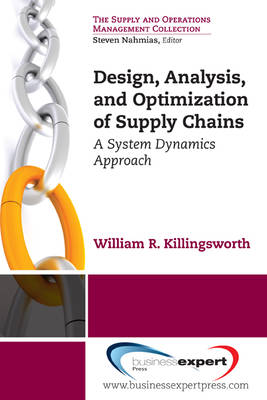
- Retrait gratuit dans votre magasin Club
- 7.000.000 titres dans notre catalogue
- Payer en toute sécurité
- Toujours un magasin près de chez vous
- Retrait gratuit dans votre magasin Club
- 7.000.0000 titres dans notre catalogue
- Payer en toute sécurité
- Toujours un magasin près de chez vous
Design, Analysis and Optimization of Supply Chains
A System Dynamics Approach
William R Killingsworth
30,95 €
+ 61 points
Description
Intended for an audience of graduate students, executive MBA students, and mid-to upper level government and corporate managers, Design, Analysis and Optimization of Supply Chains: A System Dynamic Approach examines the complexity of the types of organizations that comprise a modern supply chain, the problems that arise as a result of this complexity, and the solutions and analytical approaches available to managers that can help resolve these real world problems and dilemmas. The modern enterprise, be it a large corporation or a government agency, has two key dimensions of complexity: static and dynamic. The static complexity refers to the remarkable number of companies and agencies that enable delivery of the product or service. A static "snapshot" of this end-to-end enterprise would reveal hundreds if not thousands of companies involved in the supply network and many additional firms involved in the distribution and delivery to customers. Planning, communication, coordination and execution of this large system network is fundamentally challenging just because of the sheer size. This large, extended network represents the static complexity. The dynamic complexity arises from the difficulty of managing the performance of this extended enterprise over time. This requires having the appropriate metrics to track performance over time, the management skills to develop strategies, the ability to collect and monitor the correct data for true visibility, and the recognition and understanding of the long lags between actions and results. Design, Analysis and Optimization of Supply Chains: A System Dynamic Approach incorporates real-world examples and cases, representing actual complex enterprise systems including firms involved and with long lead times, to illustrate the multi-faceted activities occurring within a modern supply chain and the challenges they pose to managers. Simulation and optimization techniques are introduced and used to develop strategies for improved performance.
Spécifications
Parties prenantes
- Auteur(s) :
- Editeur:
Contenu
- Nombre de pages :
- 228
- Langue:
- Anglais
- Collection :
Caractéristiques
- EAN:
- 9781606492512
- Date de parution :
- 23-06-11
- Format:
- Livre broché
- Format numérique:
- Trade paperback (VS)
- Dimensions :
- 152 mm x 229 mm
- Poids :
- 312 g

Les avis
Nous publions uniquement les avis qui respectent les conditions requises. Consultez nos conditions pour les avis.






